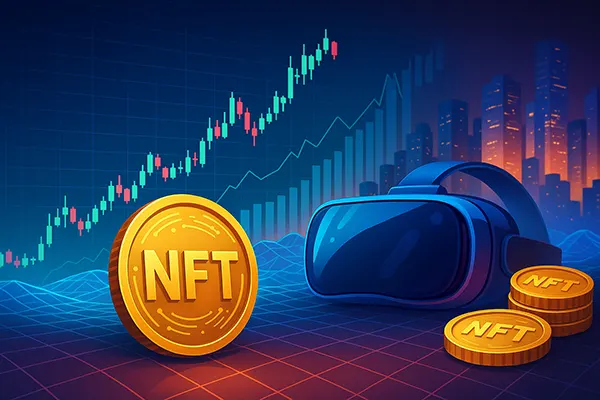
Verified Ways to Earn with Digital Assets: NFT, PFP Collections, Metaverse Risks and Real Prospects
Digital assets have expanded far beyond experimental concepts and have become a functional part of the global economy. By 2025, the NFT ecosystem, metaverse environments and PFP collections have developed new revenue models, legal protections and transparent risk frameworks. However, opportunities in this field require a sober assessment of market volatility, regulatory nuances and long-term sustainability. This article explains proven earning methods, the actual risks involved and practical considerations for anyone exploring digital asset income streams.
Non-Fungible Tokens as a Revenue Tool
By 2025, NFTs remain a widely used instrument for digital ownership. They allow artists, collectors and brands to monetise unique assets, including art, gaming items and tokenised digital rights. The growth of Ethereum Layer-2 solutions and alternative blockchains has reduced transaction fees, making NFT minting and trading more accessible.
Many creators generate income through primary sales, but long-term revenue usually comes from royalties embedded at the smart contract level. These royalties are triggered each time the asset changes ownership on supported marketplaces. Still, the ability to earn depends heavily on demand, community activity and legal compliance regarding intellectual property.
The main strength of NFTs lies in transparency: ownership records cannot be altered, and transfer history remains public. Yet the earning potential relies on realistic pricing strategies and careful handling of market fluctuations. NFT income is rarely stable, so participants should monitor liquidity and authentication standards.
Key Risks Within the NFT Market
Price instability remains a major challenge. NFT values often shift due to speculative behaviour, influencer activity or sudden shifts in market sentiment. Even high-performing collections can experience sharp declines. Investors must avoid treating NFTs as guaranteed high-return assets.
Another real risk concerns intellectual property violations. A large number of NFTs appear each year without verified ownership, and marketplaces increasingly remove such items. Buyers must check metadata sources, licensing terms and contract addresses before engaging in any transaction.
Security risks are also significant. Scammers deploy fake minting links, phishing schemes and malicious smart contracts. Hardware wallets and secure verification procedures are essential for protecting assets and preventing unauthorised transfers.
PFP Collections and Community-Driven Earning Models
PFP collections (Profile Picture collections) continue to operate as a distinct digital subculture. By 2025, the successful ones combine utility, intellectual property rights, brand deals and real-world partnerships. Revenue opportunities arise from licensing, commercial rights and participation in community projects.
Some users earn by actively developing the brand identity of their PFP assets. This includes collaborations with companies, merchandise agreements and participation in events. Owners of rare items typically gain greater potential for monetisation because rarity often determines the scope of licensing opportunities.
However, sustained value depends on long-term support from the team behind the collection. Transparency regarding development plans, treasury management and governance mechanisms is critical. Communities that maintain consistent communication tend to experience more stable engagement.
Risks Associated with PFP Collections
The main risk is an abrupt decline in community interest. Even technically strong collections lose value when activity slows down or leadership changes direction unexpectedly. A community-driven model requires consistent delivery from the creators and genuine engagement from holders.
Liquidity problems are another concern. Many collections have limited buyer pools, causing difficulties when holders attempt to sell assets quickly. This can lead to price slippage or long periods without completed sales.
Regulations also influence the sector. Some jurisdictions classify certain digital assets as financial instruments when they promise profit-sharing or investment-like benefits. Misinterpreting these rules may expose holders to legal risks or tax obligations.

Earning in Metaverse Environments
Metaverse ecosystems provide numerous income models, ranging from virtual land rentals to digital service businesses. In 2025, major metaverse platforms offer structured marketplaces, verified creator programmes and tools for business integration. Developers, designers and entrepreneurs earn by building experiences, offering digital goods or providing services such as education, consulting or entertainment.
Virtual land remains a popular asset, but profitability depends on location, platform popularity and ongoing user engagement. Successful owners often collaborate with brands or host events to increase traffic and rental demand. Passive ownership without active development rarely generates meaningful income.
Another earning model includes avatar customisation services, virtual architecture, advertising and metaverse-based customer interactions. Many international companies now operate branded spaces, increasing demand for freelance specialists able to design, moderate or maintain these environments.
Metaverse Risks to Consider
Platform dependency represents a substantial risk. If a metaverse environment loses users or closes due to financial issues, assets within it may lose value. Diversification across multiple platforms reduces exposure to such scenarios but requires additional time and resources.
Technical vulnerabilities can also affect earnings. Server outages, contract bugs or compromised accounts may lead to asset loss or reduced profitability. Regular updates, backups and secure authentication methods help mitigate these problems.
Finally, regulatory uncertainty remains relevant. Governments are gradually defining rules for virtual property, taxation and digital business activities. Participants must follow updates to avoid non-compliance, especially when operating commercially within digital worlds.



